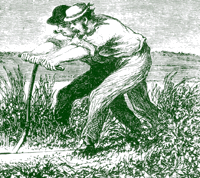 |
|
|||
Objectives Students will be able to:
Materials A variety of magazines for investigation into advertising technique and examples Copy of Salt Hay Fact Sheet (one per group of four students) (with graphics) Photographs/sketches of salt hay harvesting (NEED) A variety of art supplies for designing and creating advertisements Making Connections
Background In addition, Historic Themes and Resources, page 65. Reprinted from Barnegat Bay Decoy and Baymen’s Museum Fact Sheet, Salt Hay Harvesting, by Terry O’Leary, Program Director Gathering salt hay has been a traditional resource-based occupation along the Jersey Coast since colonial times. The arduous task of cutting, raking, baling and transporting salt hay from the wet, muddy and insect infested salt marshes of South Jersey was offset by the fact that literally tons of salt hay could be harvested annually without cultivation. In addition, the wide variety of uses for salt hay made it a valuable crop for the early settlers and the salt hay industry continued to thrive until just a few years ago. Salt hay is virtually impervious to rot and it contains no weed seeds like other types of hay. The fine wiry salt hay has been used as insulation material in preventing frost damage for tender agricultural crops such as strawberries, and for insulating freshly poured concrete. Salt marshes have also been used in the past as pasture land. Many of the barrier islands, once virtually uninhabited, were used as pasture by free ranging cattle. The best producing salt meadows yielded up to three tons of salt hay per acre and could be harvested twice during the growing season. Four types of salt hay generally harvested from the salt meadows are:
Salt hay was used to prevent erosion on construction sites. Builders have used salt hay over concrete work and masonry to prevent freezing. It is used for drainage in dry-well construction and around septic tanks. Bulkheaders have used salt hay around docks and behind bulkheads. It was used as bedding in stables. After being used and mixed with manure, although it was slow to decompose, it did ultimately produce an excellent compost. Nurseries and farmers used salt hay as a mulch in gardening, seeding lawns, and landscaping. It was a packing material for bricks, glassware and pottery, and was the chief insulation material for old time icehouses. Salt hay was placed on sugar sand roads to provide traction. It was also the chief raw material in the once prosperous industry at Harrisville to make brown butcher paper and heavy grade wrapping paper, with one mill there turning out nearly a ton of paper a day. Years ago, market gunners packed barrels of ducks and geese with layers of salt hay and shipped the waterfowl by train to fine restaurants in New York and Philadelphia. The harvesting of salt hay was a specialized business — a tribute to the resourcefulness of the baymen. After the salt hay was cut either by hand with a scythe, or with a horse-powered mowing machine, it was raked into windrows and then pitch forked into haycocks and left to dry for about one week. The salt hay was then hand loaded onto a shallow draft hay scow, heaped into an enormous stack and towed by one or more pole boats or sailing garveys to be shipped to market. Uses of Salt Hay Fact Sheet Procedure Warm Up Begin the discussion by having students flip through and skim magazines for advertisements. This may be done individually and/or in small groups, or even as a preparatory homework assignment. Advertisements that are eye-catching, persuasive, and well laid out, or could generally be considered a success or effective, should be cut out and glued/taped to a piece of paper. Each student could be responsible for one or two of the best advertisements they can find. For each advertisement, students should determine the qualities and criteria that make it a successful advertisement. This, again, could be done as a small group or individually. The Activity
Wrap Up Action Identifying traditional families that were involved and applying the activity Saving Local History in the Cultural and Historical section could be an appropriate way to tie together a sequence of events, topics, and issues regarding the region we call "Down Jersey." Assessment As per behavioral objectives identified in the beginning of activity. The actual completion of assignment and creation of an advertisement, as well as overall participation in the activity’s components. Extensions Questions to consider and for further discussions and development of activity: There was a higher demand in the past and more people involved/employed in salt hay farming along the Delaware Bay shore and the entire Mid-Atlantic Coast. Why? What items and products have replaced the functions and uses of salt hay? Are they more readily available and economically feasible alternatives? i.e., Styrofoam peanuts for packing, bubble wrap, "bagged" mulch, fodder (cultivated, high yielding, grain crops) etc. What are some of the environmental impacts of the alternative products? What were some of the impacts of salt hay farming? Compare them. Invite a salt hay farmer to present to class: conduct oral histories: share students’ advertisements with the community and farmers. Please download the PDF for the complete Lesson Plan.
PSE&G Estuary Enhancement fact sheets. Contact Marcia Walton, Education Coordinator, at (609) 339-7915 From Marsh to Farm: The Landscape Transformation of Coastal New Jersey, by Kimberly Sebold, National Park Service, available from the NJ Coastal Heritage Trail Office at (609) 447-0103 for $7 per copy. |
|||

 The historical harvest and uses for salt hay have had a significant impact and influence on the Delaware Bayshore region. Many of the salt-marshes were diked and transformed. This practice caused alterations in the natural flow of tidal water, as well as the dominant plant and animal communities that resulted. Salt hay harvesting was an integral part of the past of the Down Jersey region.
The historical harvest and uses for salt hay have had a significant impact and influence on the Delaware Bayshore region. Many of the salt-marshes were diked and transformed. This practice caused alterations in the natural flow of tidal water, as well as the dominant plant and animal communities that resulted. Salt hay harvesting was an integral part of the past of the Down Jersey region. Perhaps the most common natural landscape and habitat associated with the Southern Bayshore of New Jersey, and indeed the entire Mid-Atlantic estuarine environment, is the salt marsh. The salt marshes of southern New Jersey are vast meadows that stretch across the entire Bayshore region. These wetlands fringe the brackish influx of water as it meanders and moves with the tides up the adjacent shoreline. As you move up the rivers and tributaries, the salt marshes gradually give way to fresh water marshes as the salinity decreases. Salt marshes are a significant natural feature of the landscape of Southern New Jersey, and play a significant role in the development of the region. Both directly and indirectly, the salt-marsh is responsible for most everything presented in the film Down Jersey.
Perhaps the most common natural landscape and habitat associated with the Southern Bayshore of New Jersey, and indeed the entire Mid-Atlantic estuarine environment, is the salt marsh. The salt marshes of southern New Jersey are vast meadows that stretch across the entire Bayshore region. These wetlands fringe the brackish influx of water as it meanders and moves with the tides up the adjacent shoreline. As you move up the rivers and tributaries, the salt marshes gradually give way to fresh water marshes as the salinity decreases. Salt marshes are a significant natural feature of the landscape of Southern New Jersey, and play a significant role in the development of the region. Both directly and indirectly, the salt-marsh is responsible for most everything presented in the film Down Jersey.